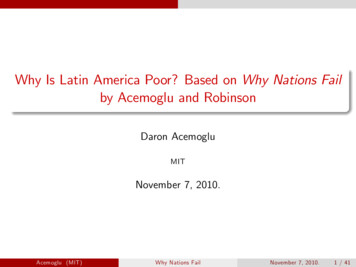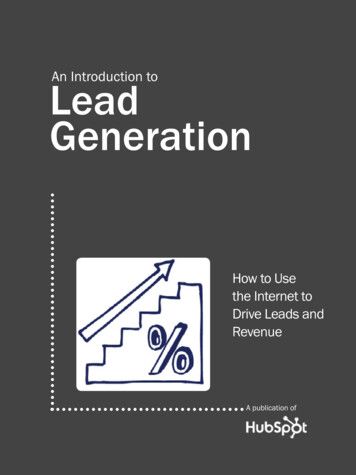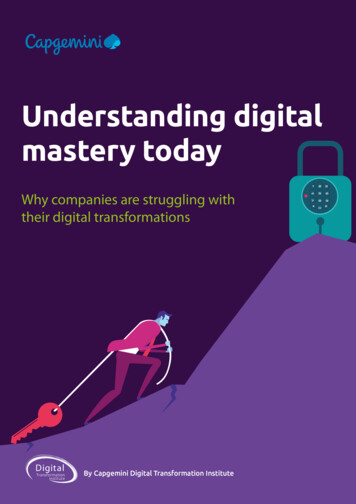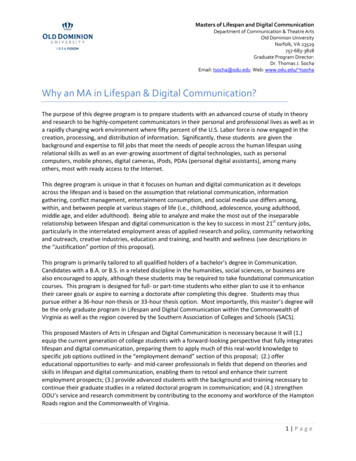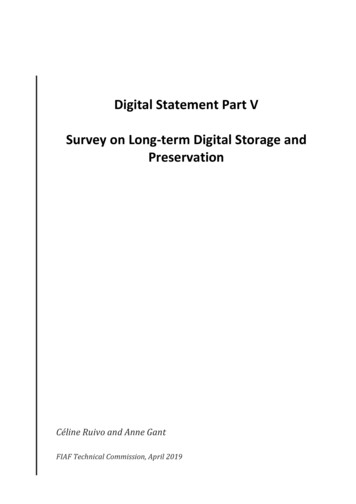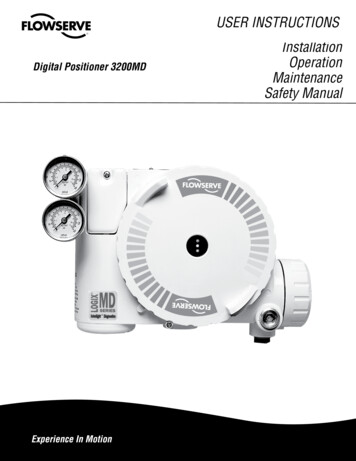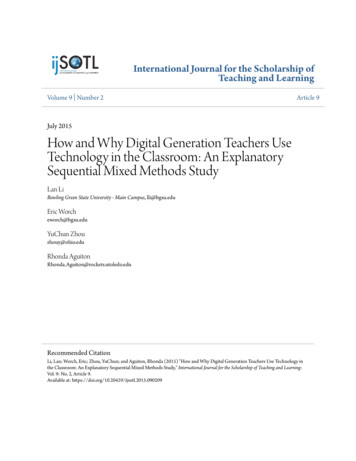
Transcription
International Journal for the Scholarship ofTeaching and LearningVolume 9 Number 2Article 9July 2015How and Why Digital Generation Teachers UseTechnology in the Classroom: An ExplanatorySequential Mixed Methods StudyLan LiBowling Green State University - Main Campus, lli@bgsu.eduEric Worcheworch@bgsu.eduYuChun Zhouzhouy@ohio.eduRhonda ed CitationLi, Lan; Worch, Eric; Zhou, YuChun; and Aguiton, Rhonda (2015) "How and Why Digital Generation Teachers Use Technology inthe Classroom: An Explanatory Sequential Mixed Methods Study," International Journal for the Scholarship of Teaching and Learning:Vol. 9: No. 2, Article 9.Available at: https://doi.org/10.20429/ijsotl.2015.090209
How and Why Digital Generation Teachers Use Technology in theClassroom: An Explanatory Sequential Mixed Methods StudyAbstractWhile teachers’ conservative attitude toward technology has been identified as a barrier to effectivetechnology integration in classrooms, it is often optimistically assumed that this issue will resolve when thedigital generation enters the teaching profession (Morris, 2012). Using a mixed methodology approach, thisstudy aimed to examine the current technology usage of digital generation student teachers and the impact ofpossible internal and external barriers (such as self-efficacy, risk taking, and technology access and support)on their use of technology. Seventy-one student teachers first responded to an online survey regarding theirtechnology use in classrooms. Afterwards, six participants were purposefully selected, based on their surveyresponses, to participate in follow-up interviews about their attitudes toward technology and challenges ofintegrating technology to teaching. Findings of the study suggested that digital generation student teachers’use of technology in the classroom was significantly correlated with their self-efficacy, perceived computerskills, and technology access and support. However, the participants’ perceived level of risk taking was notrelated to their use of technology in the classroom. Findings of the study suggest that digital native studentteachers have not necessarily become more comfortable keeping pace with the fast rate of change intechnology. Implications of findings are discussed.KeywordsDigital Generation, Student Teachers, Classroom Technology Integration, Internal and External BarriersCover Page FootnoteThe authors acknowledge the Research Development Council of the College of Education and HumanDevelopment at Bowling Green State University for providing funding and support for this research.
IJ-SoTL, Vol. 9 [2015], No. 2, Art. 9How and Why Digital Generation Teachers Use Technology in the Classroom:An Explanatory Sequential Mixed Methods StudyLan Li, Eric Worch,YuChun Zhou, and Rhonda AguitonCollege of Education and Human Development, Bowling Green State University, Bowling Green, Ohio 43403, USA(Recieved: 18 Feburary 2015; accepted: 22 May 2015)While teachers’ conservative attitude toward technology has been identified as a barrier to effective technology integrationin classrooms, it is often optimistically assumed that this issue will resolve when the digital generation enters the teachingprofession (Morris, 2012). Using a mixed methodology approach, this study aimed to examine the current technology usageof digital generation student teachers and the impact of possible internal and external barriers (such as self-efficacy, risktaking, and technology access and support) on their use of technology. Seventy-one student teachers first responded to anonline survey regarding their technology use in classrooms. Afterwards, six participants were purposefully selected, basedon their survey responses, to participate in follow-up interviews about their attitudes toward technology and challenges ofintegrating technology to teaching. Findings of the study suggested that digital generation student teachers’ use of technology in the classroom was significantly correlated with their self-efficacy, perceived computer skills, and technology accessand support. However, the participants’ perceived level of risk taking was not related to their use of technology in theclassroom. Findings of the study suggest that digital native student teachers have not necessarily become more comfortablekeeping pace with the fast rate of change in technology. Implications of findings are discussed.INTRODUCTIONRapidly evolving technology has not only fundamentally changed theway in which we live, work and communicate, but also revolutionized the education system. A wealth of studies investigating waysof harnessing technology to transform teaching and learning suggest that technology, when used appropriately, offers great promises to facilitate teaching, engage students and increase studentslearning achievement (e.g. Mann, Shakeshaft, Becker, & Kottkamp,1999; Funkhouser, 2002-2003; Salpeter, 1999). Technology access inclassrooms has been steadily growing in the last two decades andeducation is experiencing an increase in classroom technology demands (Martin, 2011).Despite great potentials and increasing accessibility of technology in schools, teachers are usually portrayed as reluctant andskeptical technology users (e.g. Carlson & Gadio, 2002; Ertmer &Hruskocy, 1999; Eteokleous, 2008). Studies suggest relatively fewteachers are willing to fully exploit technology within their classrooms (e.g. Marcinkiewicz, 1993;Wang, Ertmer, & Newby, 2004) andeffective technology integration in classrooms is still remarkablylow (Cuban, 2001; Cuban, Kirkpatrick, & Peck, 2001). Further, Lei(2009) reviewed the historical role of teachers in relation to technology and described it as “has not been very positive” (p. 88).Teachers’ hesitancy around technology has become a prominentissue in education as the responsibility for effective technology integration inevitably falls upon individual teachers.While teachers’ conservative attitude toward technology hasbeen identified as one of the top barriers in classroom technologyintegration, it is often assumed that this issue will mitigate when thedigital natives enter the teaching profession (Morris, 2012). Digitalnatives, characterized by Prensky (2001), are individuals who growup in the digital world with digital technology as an integral part oftheir lives. Palfrey and Gasser (2008) further define digital nativesas those born after 1980 who have access to technology, possesstechnology skills, and feel comfortable using technology. Most ofthe existing literature has sketched a quite promising and ng picture of digital natives (Lie, 2009). They are often describedas the “millennial generation” (p. 421) that is socially connected,digitally literate, shows strengths in multitasking and collaboration,and values immediacy (McMahon & Pospisil, 2005). They are believed to live in a ubiquitous digital environment and are the trulynative speakers of the digital language (Prensky, 2001). Accordingto Winn (cited in Oppenheimer, 1997, p. 14), digital natives have adigital mindset with which they “think differently from the rest ofus. They develop hypertext minds. They leap around. It’s as thoughtheir cognitive structures were parallel, not sequential.” Based onthe above unique traits of digital natives, some researchers andeducators posit that technology integration would cease being aproblem when digital native teachers establish their curriculumsand classroom practices (Carr, 2010).Since digital natives have now entered the teaching forefront,is technology integration in classrooms no longer a problem aspreviously assumed? Unfortunately, a recent survey (The RichardW. Riley College of Education and Leadership at Walden University,2010) revealed that although early career digital native teachersmay be proficient users of technology in their personal sphere, theyare NOT more likely to adopt technology in teaching compared toveteran teachers. This seemingly surprising finding is in agreementwith a list of other studies, which suggest that new career teachers’technology skills are evidently improved (Polly, Mims, Shepherd, &Inan, 2010), yet enhanced technology skills do not automaticallytransform and augment curriculum (Wang, 2002; Zhao & Bryant,2005).Clearly, there is a gap between digital native teachers’ technology skills and effective classroom technology integration. Whatbarriers are preventing teachers from effectively integrating technology in curriculum? According to Ertmer (1999), there are twotypes of technology barriers that may affect teachers’ technologyuse: external and internal. External barriers encompass a range oftopics mainly concerning institutional factors such as inadequatetechnology access, time, training and support. Osika (2006) posits1
Digital Generation Teachers Technology Usethat support from the entire institution is essential to successfultechnology integration in curriculum. Unfortunately, systematicsupport from some institutions has been limited and inconsistent(Ronnkvist, Dexter & Anderson, 1998). Internal barriers includevariables such as teachers’ underlying attitudes and beliefs towardstechnology. Ertmer (1999) ranks external barriers as “first handorder” and internal barriers as “second hand order”, and furtherstates that it will be difficult to integrate technology with first handorder barriers present. However, even with first hand order obstacles cleared, teachers still may not “automatically use technology toachieve meaningful outcomes advocated” (p. 51).There is mountingevidence suggesting teachers’ beliefs and attitudes toward technology may greatly influence their effective technology implementation in the classroom (e.g. Albion, 1996; Marcinkiewicz, 1993; Oliver& Shapiro, 1993; Woodrow, 1992).The purpose of this mixed methods study was to investigatedigital native teachers’ use of technology in classrooms. In the initialquantitative survey phase of this study, the researchers aimed toexamine the relationships between the external barriers (technology access and support), internal barriers (attitudes and beliefs—risk taking and self-efficacy) and technology use in digital nativeteachers’ classrooms. The follow-up qualitative interview phasehelped to explain the quantitative findings. The integration of survey results and interviews helps to build a deeper understanding ofdigital native teachers’ use of technology in classrooms. Specifically,this study consisted of the following quantitative, qualitative, andmixed methods research questions.Quantitative Research Questions:1. Whether and to what extent does risk taking influence participants’ use of technology in the classroom?2. Whether and to what extent does self-efficacy influence participants’ use of technology in the classroom?3. Whether and to what extent does technology support and access influence participants’ use of technology in the classroom?After analyzing the quantitative data, the researchers foundthe need to explore the nonsignificant relationship between risktaking and use of technology as well as the significant relationshipbetween external support and use of technology. Therefore, theresearchers generated the following qualitative and mixed methodsresearch questions:Qualitative Research Questions:1. Why does risk taking not influence participants’ use of technology in the classroom?2. How does technology support and access influence participants’use of technology in the classroom?TerminologyRisk Taking. In the current study, risk taking refers to “teachers’emotional responses of comfort and anxiety when troubleshootingor risk-taking with new technology” (Hastings, 2009, p. 13). Thepossibility of facing failure prevents teachers from endeavoring withthe implementation of new technology (Zhao & Bryant, 2005). Other forms of emotional discomfort that teachers experience withtechnology innovations are the fear of equipment failure, embarrassment and frustration (Means, 1994; Gahala, 2001) even thoughthey are quite comfortable using it for personal use (Curtis, elf-efficacy. Bandura (1997) defines self-efficacy as a person’s belief in his or her capability to successfully accomplish aspecific task. Mager (1992) suggests that self-efficacy can have animpact on one’s motivation, behavior, perseverance and thoughtpatterns, which in turn can affect their work performance. He further claims those with low self-efficacy may defer from taking risks.Studies suggest that teacher beliefs about the use of technology inteaching and best practices in classrooms are positively correlated(e.g. Albion, 1999).METHODSResearch DesignThis study employed the explanatory sequential mixed methodsresearch design (QUANTITATIVE qualitative explanation),which included an initial quantitative survey and the follow-up qualitative interview with the priority on the quantitative phase. Thequalitative results helped explain the initial survey results and buildbetter understanding of the significant and nonsignificant quantitative findings.Mixed methods was defined as “a third methodological movement” following quantitative and qualitative methods (Teddlie &Tashakkori, 2009, p. 5). Mixed methods is both a method and methodology. As a method, it is an approach and techniques to collect,analyze, and mix qualitative and quantitative data.As a methodology,it involves the integration of qualitative and quantitative methodsin many stages in the research process: from philosophical assumptions to data collection and analysis. The core rationale of usingmixed methods is that the combined use of both qualitative andquantitative methods can provide a better understanding of research issues than a single method (Creswell & Plano Clark, 2012;Tashakkori & Teddlie, 1998).The explanatory sequential design is one of the most common designs in mixed methods research. It consists of two distinctint
Research Design This study employed the explanatory sequential mixed methods research design (QUANTITATIVE qualitative explanation), which included an initial quantitative survey and the follow-up qual-itative interview with the priority on the quantitative phase. The qualitative results helped explain the initial survey results and build


